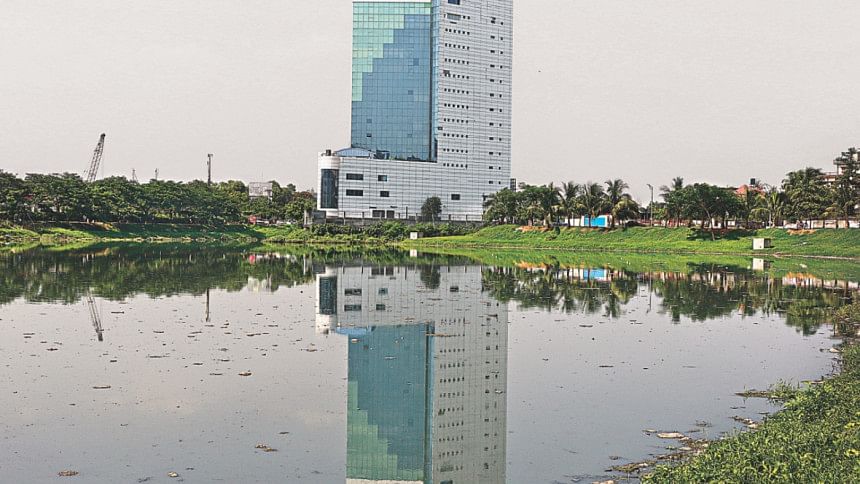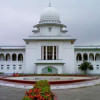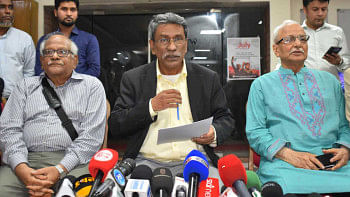BGMEA building must come down

The Supreme Court yesterday upheld a 2011 High Court verdict that ordered demolition of the 15-storey BGMEA building illegally built in the heart of Begunbari canal in the capital.
The HC in April 2011 ordered the authorities to demolish the building in the Begunbari-Hatirjheel canal within three months, saying it was built on a land acquired through forgery and earth-filled the water body illegally.
Later, the SC stayed the HC order following a petition filed by the BGMEA.
BGMEA President Siddiqur Rahman told The Daily Star that they would file a review petition with the SC.
However, Manzill Murshid, an SC lawyer who was present in the court during yesterday's hearing, told this correspondent that now, there is no need for full text of the SC order for knocking down the building, as the authorities concerned had earlier received the full verdict of the HC which is now in effect.
A four-member bench of the Appellate Division headed by Chief Justice Surendra Kumar Sinha passed the order after dismissing a leave to appeal petition filed by Bangladesh Garment Manufacturers and Exporters Association (BGMEA), the apex body of apparel industry.
The BGMEA building has been in the way of the storm drainage system -- one of the Hatirjheel integrated scheme's prime objectives -- to drain stormwater out of Paribagh, Karwan Bazar and Eskaton, according to the relevant technical experts.
The Begunbari canal stretching from Kazi Nazrul Islam Avenue to Rampura and beyond is a vital drainage system to help mitigate urban flooding in the capital, said Professor Mujibur Rahman, who led the technical expert team of the scheme.
Dhaka's master plan earmarks the Begunbari canal as a natural water body and a designated flood flow zone, prohibiting any change to its character.
The much-hyped Hatirjheel-Begunbari integrated development scheme was opened in January 2013 with the illegal building standing boldly right in the middle of the Begunbari canal.
Terming the SC order a historic decision, lawyer Manzill, who was as an amicus curiae (friend of court) in the hearing of the case at the HC, said the people's confidence in rule of law will be enhanced following the SC order, as they will now feel that nobody is above the law.
Syeda Rizwana Hasan, chief executive of Bangladesh Environmental Lawyers Association, told this correspondent that the SC order will help speed up the water body protection movement from land grabbers.
The apex court order is a big milestone against the culture of impunity in the society, she added.
The HC in 2011 said the records submitted by the office of deputy commissioner of Dhaka proved that the land was acquired for the then East Bengal Railway in 1910 and it was in the possession of the Bangladesh Railway until 2006.
The railway authorities handed over the land to the Export Promotion Bureau (EPB) in 2006. Surprisingly, it was found in the documents submitted by the BGMEA that it purchased the land from the EPB in 2001.
The HC delivered the judgment after hearing a suo moto rule issued by another HC bench taking cognizance of a newspaper report in October 2010.
The full text of the HC judgment, released in March 2013, observed that the BGMEA building stood in Hatirjheel project “like a cancerous growth” and structures like these would swamp the whole city unless the building was removed forthwith.
The court also ordered the authorities to pull the building down and use the land in the public interest and directed the BGMEA to provide refunds to the people who bought floor spaces in the building.
Prime Minister Sheikh Hasina during her first tenure laid the foundation stone of the BGMEA building in November 1998, while former premier Khaleda Zia inaugurated the building in October 2006.
Rajdhani Unnayan Kartripakkha (Rajuk) issued land use clearance while the Department of Environment issued environmental clearance and Dhaka Water Supply and Sewerage Authority (Wasa) clearance for the building in the canal. Civil Aviation Authorities also issued the height clearance.
Besides those clearances, the BGMEA authorities needed to obtain building approval from Rajuk, which they did not. Rajuk only served one notice on the BGMEA authorities about this in more than a decade of the building's existence.
Various environmental and civic groups time and again demanded that the government take steps to knock the illegal BGMEA building down.
BGMEA's lawyer barrister Rafique-ul Huq said, “I personally feel that demolition of the BGMEA building will have a very bad effect on the garment sector and the economy of the country, as the economy depends on the garment industry.”
The Supreme Court said the water body, where the BGMEA building was constructed, was filled up in violation of the wetlands conservation act.
During yesterday's hearing, it also asked Attorney General Mahbubey Alam how the Rajuk let the BGMEA fill up the water body.
The attorney general said he did not know about it and he had no argument in this regard.

 For all latest news, follow The Daily Star's Google News channel.
For all latest news, follow The Daily Star's Google News channel. 








Comments